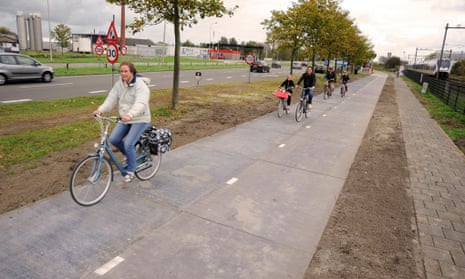The bike path that connects the Amsterdam suburbs of Krommenie and Wormerveer is popular with both school children and commuters: around 2,000 cyclists ride its two lanes on an average day.
But next week Krommenie’s cycle path promises to become even more useful: on 12 November a 70-metre stretch will become the world’s first public road with embedded solar panels.
Costing around €3m (£2.4m) and funded mostly by the local authority, the road is made up of rows of crystalline silicon solar cells, encased within concrete and covered with a translucent layer of tempered glass.
A non-adhesive finish and a slight tilt are meant to help the rain wash off dirt and thus keep the surface clean, guaranteeing maximum exposure to sunlight.
Since the path cannot be adjusted to the position of the sun, the panels produce roughly 30% less energy than those fixed on to roofs. Nonetheless, when the path is extended to 100 metres in 2016, its creators hope that it will produce enough energy to power three households.
The Netherlands’ TNO research institute, which developed the concept behind the solar bicycle path, think the potential of their idea doesn’t stop there. Sten de Wit of the institute told the Guardian that up to 20% of the Netherlands’ 140,000km of road could potentially be adapted, helping to power anything from traffic lights to electric cars. Tests have seen the solar panel units successfully carry the weight of heavy vehicles such as tractors.
While Krommenie will become the first community in the world with a publicly accessible stretch of solar road, the idea of using existing road infrastructure to harvest solar energy is gaining momentum across the globe.
Two US engineers, Idaho couple Julie and Scott Brusaw, have been developing solar panelling units for road use since 2006. In 2009, their company Solar Roadways received a contract from America’s Federal Highway Administration to build a prototype.
In March this year, the Brusaws replaced their own parking lot with solar-panelled units, and thanks to a popular viral video, they have raised $2.2m (£1.4m) to put their design into production.
If all the roads in the US were converted to solar roadways, the Solar Roadways website claims, the country would generate three times as much energy as it currently uses and cut greenhouse gases by 75%.

Comments (…)
Sign in or create your Guardian account to join the discussion